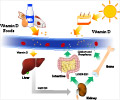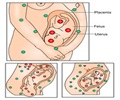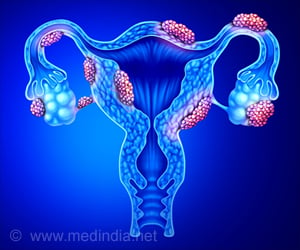Even regular use of prenatal multivitamin supplements is not adequate to prevent vitamin D insufficiency, according to a report.
Even regular use of prenatal multivitamin supplements is not adequate to prevent vitamin D insufficiency, according to a report in the current issue of the Journal of Nutrition, the publication of the American Society for Nutrition. A condition linked to rickets and other musculoskeletal and health complications, vitamin D insufficiency was found to be widespread among women during pregnancy, particularly in the northern latitudes.
"In our study, more than 80 percent of African-American women and nearly half of white women tested at delivery had levels of vitamin D that were too low, even though more than 90 percent of them used prenatal vitamins during pregnancy," said Lisa Bodnar, Ph.D., M.P.H., R.D., assistant professor of epidemiology at the University of Pittsburgh Graduate School of Public Health (GSPH) and lead author of the study. "The numbers also were striking for their newborns – 92.4 percent of African-American babies and 66.1 percent of white infants were found to have insufficient vitamin D at birth."A vitamin closely associated with bone health, vitamin D deficiency early in life is associated with rickets – a disorder characterized by soft bones and thought to have been eradicated in the United States more than 50 years ago – as well as increased risk for type 1 diabetes, asthma and schizophrenia.
"A newborn's vitamin D stores are completely reliant on vitamin D from the mother," observed Dr. Bodnar, who also is an assistant investigator at the university-affiliated Magee-Womens Research Institute (MWRI). "Not surprisingly, poor maternal vitamin D status during pregnancy is a major risk factor for infant rickets, which again is becoming a major health problem."
For their study, Dr. Bodnar and her colleagues evaluated data that was collected on 200 black women and 200 white women who were randomly selected from more than 2,200 women enrolled in the MWRI's Pregnancy Exposures and Preeclampsia Prevention Study between 1997 and 2001. Samples of maternal blood were collected prior to 22 weeks pregnancy and again just before delivery, Samples of newborn umbilical cord blood also were tested for 25 hydroxyvitamin D, an indicator of vitamin D status. Finding such a proliferation of vitamin D insufficiency in spite of prenatal multivitamin use is troubling, she noted, suggesting that higher dosages, differing vitamin formulations or a moderate increase in sunlight exposure might be necessary to boost vitamin D stores to healthier levels.
"In both groups, vitamin D concentrations were highest in summer and lowest in winter and spring," said senior author James M. Roberts, M.D., MWRI director and professor and vice chair of research in the department of obstetrics, gynecology and reproductive sciences at the University of Pittsburgh School of Medicine. "But differences were smaller between seasons for African-American mothers and babies, whose vitamin D deficiency remained more constant."
Since vitamin D is made by the body in reaction to sunlight exposure, it has long been known that vitamin D deficiency is more common among darker-skinned individuals, particularly in more northern latitudes, where less ultraviolet radiation reaches the Earth. Indeed, vitamin D deficiency is more than three times as common in winter than in summer for all women of childbearing age in the United States. Even so, the Pittsburgh researchers' study is cause for concern.
Advertisement
Vitamin D is found naturally in fatty fish but few other foods. Primary dietary sources include fortified foods such as milk and some ready-to-eat cereals and vitamin supplements. Sun exposure for skin synthesis of vitamin D also remains critical.
Advertisement
Source-Eurekalert
SRM











